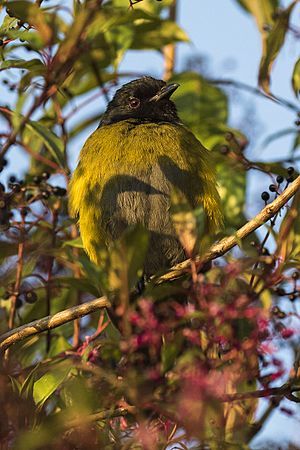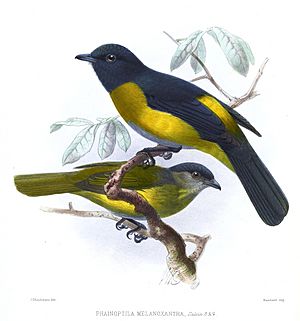Black-and-yellow phainoptila facts for kids
Quick facts for kids Black-and-yellow phainoptila |
|
|---|---|
 |
|
| Conservation status | |
| Scientific classification | |
| Genus: |
Phainoptila
|
| Species: |
melanoxantha
|
 |
|
The black-and-yellow phainoptila (pronounced fay-nop-TEE-luh), also known as the black-and-yellow silky-flycatcher, is a beautiful bird found in the forests of Costa Rica and Panama. Its scientific name is Phainoptila melanoxantha. This unique bird belongs to a family called Ptiliogonatidae, which are known as silky-flycatchers. It's the only species in its group, the genus Phainoptila.
What Does It Look Like?
The black-and-yellow phainoptila is a small, round bird. It's easy to spot because of its bright yellow sides, called flanks.
- Male birds have a black back, head, and tail. Their sides and rump (the area above the tail) are yellow. Their chest is olive green, and their belly is grey.
- Female birds look a bit different. They have a black cap on their head. Their chest, rump, wings, and tail are olive green. Their sides are yellow. Their throat, the back of their neck (called the nape), and their belly are grey.
- Young phainoptilas look similar to adult females. However, their colors are not as bright. They also don't have grey on their nape, and their chest has some dark streaks.
Where Does It Live?
Black-and-yellow phainoptilas live in the mountains of Costa Rica and western Panama. They prefer high places, from about 1,800 meters (6,000 feet) up to the tree line. The tree line is the highest point where trees can grow on a mountain.
Sometimes, after the breeding season, they might fly to lower areas. You can find them in mountain forests. They also live in areas where forests are regrowing, called second growth, and even in gardens.
Habits and Sounds
Black-and-yellow phainoptilas usually hang out in the middle and upper parts of highland forests. They mostly eat berries from trees, epiphytes (plants that grow on other plants), and shrubs.
These birds are quite slow and don't move around much. They often spend a long time eating berries from just one tree. Sometimes, they join groups of sooty-capped bush tanagers, but they often fall behind. They don't often catch insects, but sometimes they pluck them from leaves or catch them while flying.
You usually find these birds alone or in pairs. After the breeding season, they might form loose groups.
Their call is a high, sharp, thin tsit or tseep. It sounds like a much smaller bird. They don't seem to sing.
Nesting Habits
The nest of a black-and-yellow phainoptila is a compact, bulky cup. It's made from green moss, thin stems, and fern fronds.
They build their nests about 1.5 to 4 meters (5–13 feet) high. You can find these nests in a dense shrub or a young tree, called a sapling. The female bird lays two eggs. The eggs are greyish-white with spots. Nesting usually happens from April to May.
See also
 In Spanish: Capulinero negrigualdo para niños
In Spanish: Capulinero negrigualdo para niños



